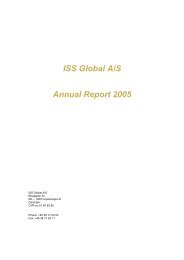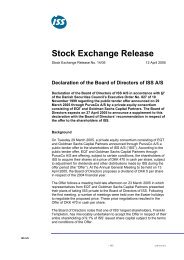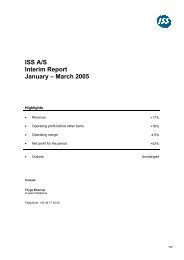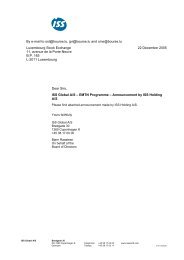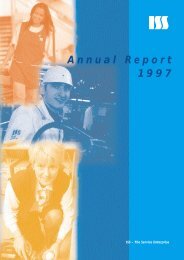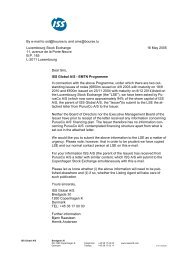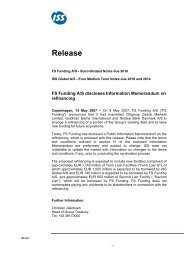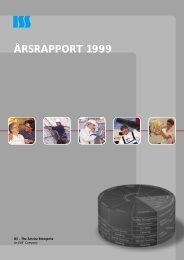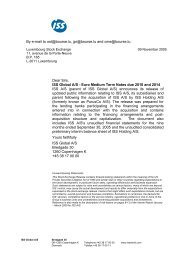Annual Report 2006 ISS Global A/S
Annual Report 2006 ISS Global A/S
Annual Report 2006 ISS Global A/S
You also want an ePaper? Increase the reach of your titles
YUMPU automatically turns print PDFs into web optimized ePapers that Google loves.
NOTES TO THE CONSOLIDATED FINANCIAL STATEMENTS<br />
1 January – 31 December. Amounts in DKK millions<br />
1. Significant accounting policies (continued)<br />
Pensions and similar obligations Net obligations in respect of defined benefit pension plans are calculated separately for each<br />
plan by estimating the amount of future benefits that employees have earned in return for their service in the current and prior<br />
periods; that benefit is discounted to determine its present value, and the fair value of any plan assets is deducted. Discount rates<br />
are based on the market yield of high quality corporate bonds or government bonds in the country concerned approximating to the<br />
terms of <strong>ISS</strong> <strong>Global</strong>’s pension obligations. The calculations are performed by a qualified actuary using the Projected Unit Credit<br />
Method. When the benefits of a plan are improved, the portion of the increased benefit relating to past service by employees is<br />
recognised as an expense in the income statement on a straight-line basis over the average period until the benefits vest. To the<br />
extent that the benefits vest immediately, the expense is recognised immediately in the income statement.<br />
All actuarial gains and losses are recognised directly in equity.<br />
Net pension assets are only recognised to the extent that <strong>ISS</strong> <strong>Global</strong> is able to derive future economic benefits in the way of<br />
refunds from the plan or reductions of future contributions.<br />
Other provisions comprises obligations concerning labour related matters, self-insurance, integration costs related to<br />
acquisitions, dismantling costs, and various other operational issues. The provisions are recognised when <strong>ISS</strong> <strong>Global</strong> has a legal or<br />
constructive obligation as a result of a past event, and it is probable that an outflow of economic benefits will be required to settle<br />
the obligation.<br />
Derivatives are measured at fair value calculated according to generally accepted valuation methods and recognised in Other<br />
receivables or Other liabilities.<br />
For derivatives hedging the fair value of recognised assets and liabilities the value of the hedged asset or hedged liability is also<br />
stated at fair value in respect of the risk being hedged. When a hedging instrument expires or is sold, terminated or exercised but<br />
the hedged asset or hedged liability with a determinable maturity still exist, the adjustment recorded as part of the carrying amount<br />
of the hedged item is amortised to the income statement from that date onwards using the effective interest method.<br />
The effective part of the changes in the fair value of derivatives hedging future transactions is recognised directly in equity, net of<br />
tax. On realisation of the hedged item, value changes recognised under equity are reversed and recognised together with the<br />
hedged item. When a hedging instrument expires or is sold, terminated or exercised but the hedged future transactions are still<br />
expected to occur, the cumulative gain or loss at that point remains in equity and is recognised in accordance with the above policy<br />
when the transaction occurs.<br />
Derivatives that qualify as net investment hedges of subsidiaries, joint ventures and associates are recognised directly in equity, net<br />
of tax.<br />
For derivatives, which do not comply with the hedge accounting conditions, changes in fair value are recognised as Net finance<br />
costs in the income statement as they occur.<br />
Non-current assets held for sale Assets are classified as held for sale when the carrying amount of the assets will primarily be<br />
recovered through a sale within 12 months according to a formal plan rather than through continuing use. Assets held for sale are<br />
recognised at the lower of the carrying amount and fair value less costs to sell. Assets held for sale are not amortised or<br />
depreciated. Impairment losses on initial classification as held for sale are included in the income statement. The same applies to<br />
gains and losses on subsequent remeasurement. Assets and related liabilities are separated in the balance sheet and the main<br />
elements are specified in the notes to the financial statements.<br />
Discontinued operations comprises a component of <strong>ISS</strong> <strong>Global</strong>’s business that represent a separate major line of business or<br />
geographical area of which the operations and cash flows can be clearly distinguished, i.e. as a minimum a cash-generating unit.<br />
Classification as discontinued operation occurs upon disposal or when the operation meets the criteria to be classified as held for<br />
sale. The profit or loss is separated in the income statement, assets and related liabilities are separated in the balance sheet, and<br />
the cash flows from operating, investing and financing activities are disclosed in the notes to the financial statements.<br />
_____________________________________________________________________________________________________________<br />
ANNUAL REPORT <strong>2006</strong> / Consolidated Financial Statements<br />
52



